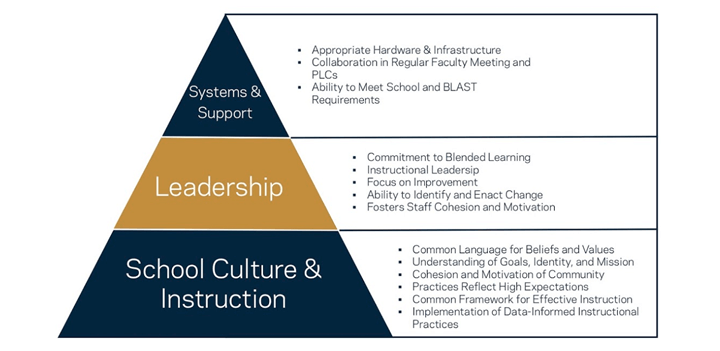In the same way that many people mistakenly confuse one-to-one technology programs with blended-learning programs, many people also assume that technology is the key to blended learning's success – but it's not, at least not in our classrooms.
The term "blended learning" can refer to a wide variety of different forms of education that combine technology with face-to-face learning, and it's true that technology is typically what distinguishes these types of learning from other, more traditional forms of learning. It is also true that the time a student spends with technology can have a significant impact, either positive or negative, on his or her learning and overall wellbeing. We carefully select every software program our students use to ensure that the time they do spend using technology is time spent mastering concepts at their unique levels in an engaging manner, and we are excited to see the positive impact these programs alone can have on student learning.
But so many factors in a blended-learning program are more crucial for success than devices or software programs, which is why "appropriate hardware and infrastructure" is just one factor, and a minor one–in our criteria for selecting a school for our Higher-Powered Learning Program. Rather than focusing on technology, we focus our selection on two far more important aspects of a school's success: the culture and instructional practices in place, and leadership.

Our primary focus on school culture and instruction springs from our fundamental belief that blended learning amplifies many of the existing characteristics of a classroom or school. Arm a solid teacher in a sound school environment with the right resources, and blended learning can allow that teacher to have a transformational impact on his or her students; throw some technology into a classroom with poor instruction and/or an unstable environment, however, and it will likely only cause both the instruction and the environment to suffer. When selecting a school for the Higher-Powered Learning Program, then, we look for indications of a strong school culture and high level of instruction such as a culture of high expectations, a common framework for effective instruction, and implementation of data-informed instructional practices, to name a few. These indicate to us that the school environment is one in which blended learning can thrive.
 We also place great emphasis on the school leader in the selection process because we agree with the Mary Ann Remick Leadership Program's belief that school leaders drive student success. The selection of the right leader is so important to us that we wrote a whole post about the criteria we, and others in our field, consider for school leaders. In our intensive application and interview process, we search for leaders who commit to implementing blended learning, focus on instruction and improvement, and motivate their staff to change.
We also place great emphasis on the school leader in the selection process because we agree with the Mary Ann Remick Leadership Program's belief that school leaders drive student success. The selection of the right leader is so important to us that we wrote a whole post about the criteria we, and others in our field, consider for school leaders. In our intensive application and interview process, we search for leaders who commit to implementing blended learning, focus on instruction and improvement, and motivate their staff to change.
If a school satisfies these two primary selection criteria, then we consider the school's technology and infrastructure. Because here's the thing–it is FAR easier to help a school buy technology or write a grant for upgrades than it is to change the school's culture or implement an instructional framework. If you are considering which schools from your diocese, district, or network should go blended, don't fall into the trap of choosing the schools with the most technology. Focus instead on these criteria, and you will be far more likely to see success.
We are so excited to be putting these criteria into action as we select schools for the first cohort of our Higher-Powered Learning Program! Do you have any advice for us? Let us know in the comments!
 Alliance for Catholic Education
Alliance for Catholic Education
